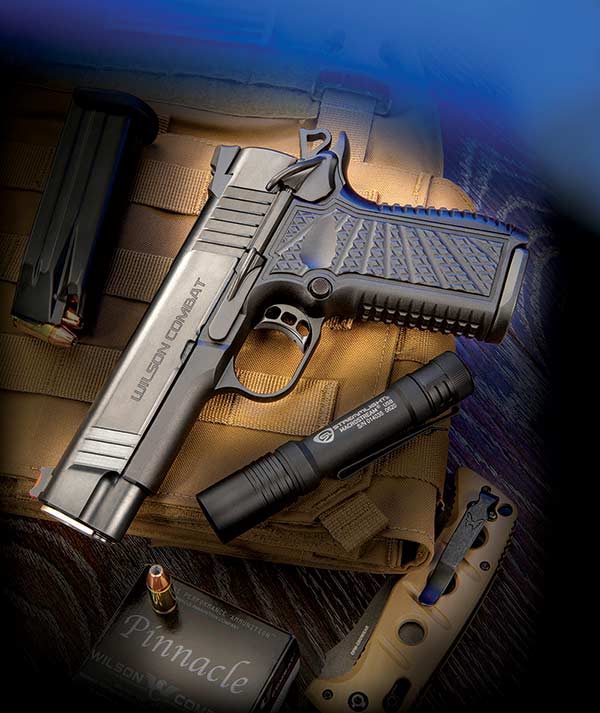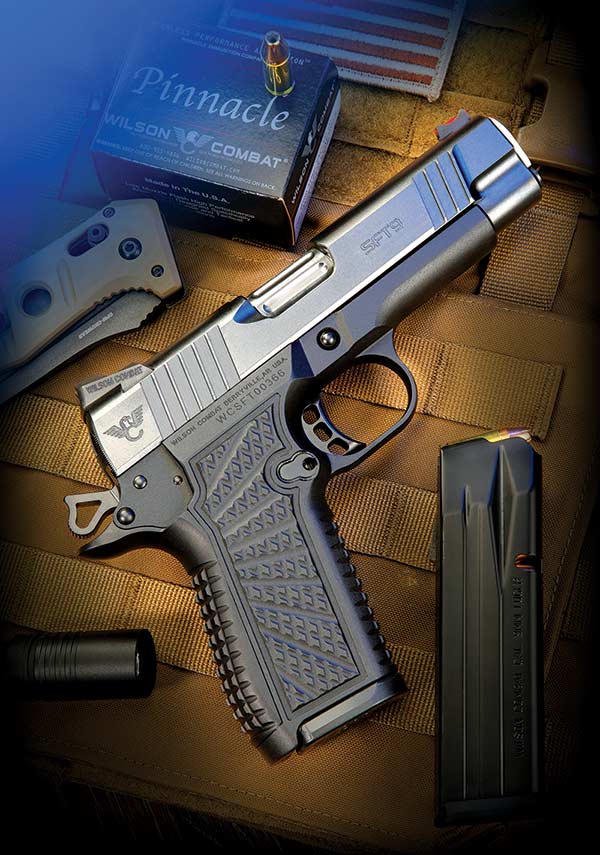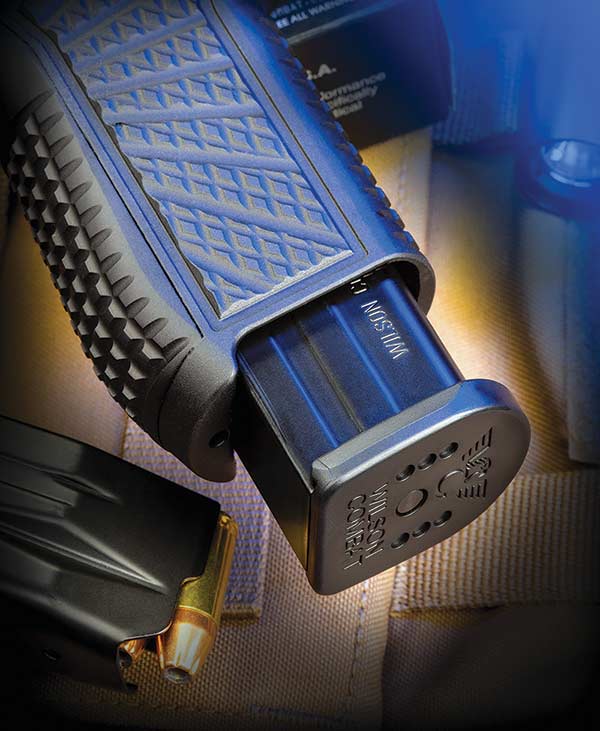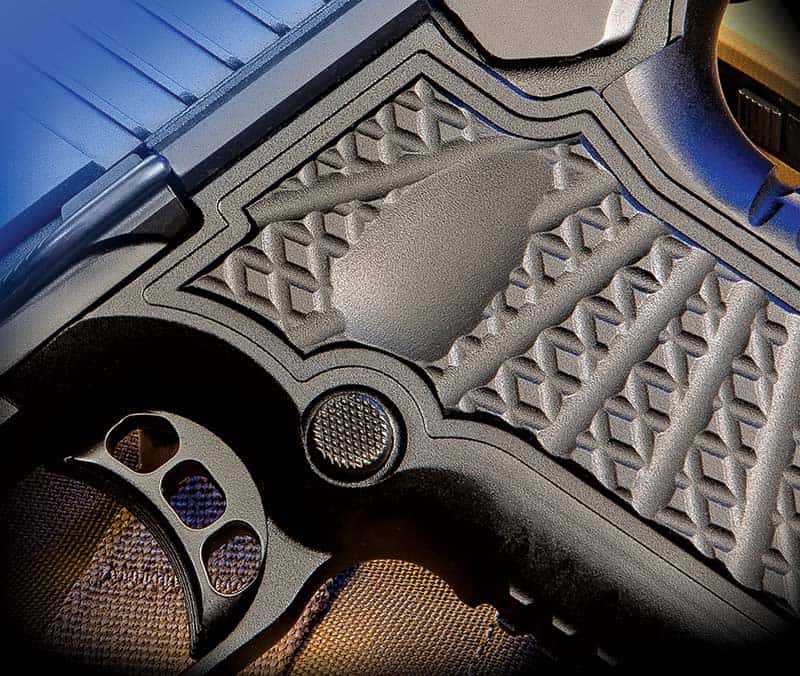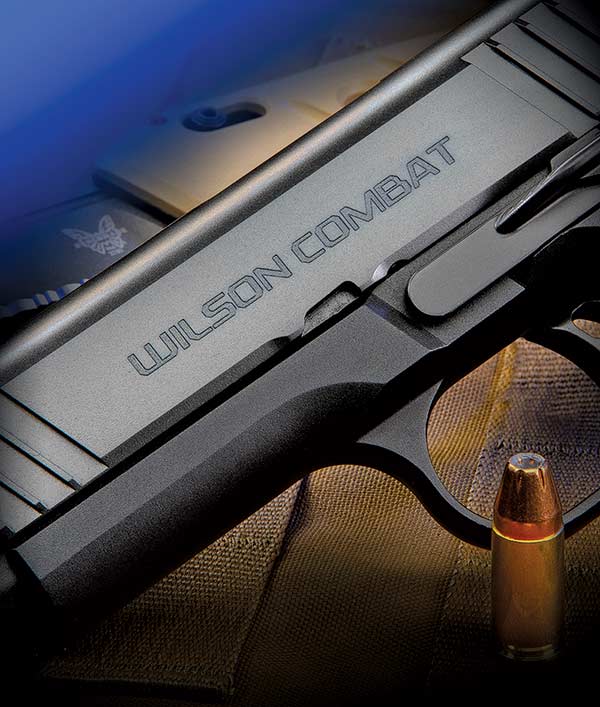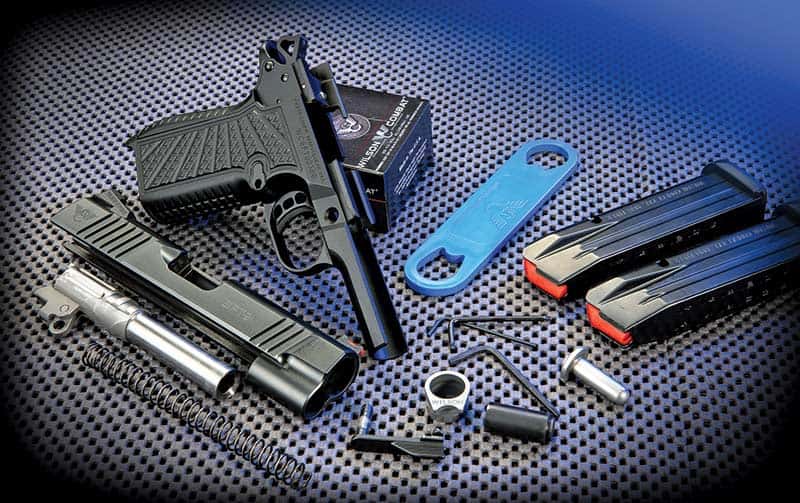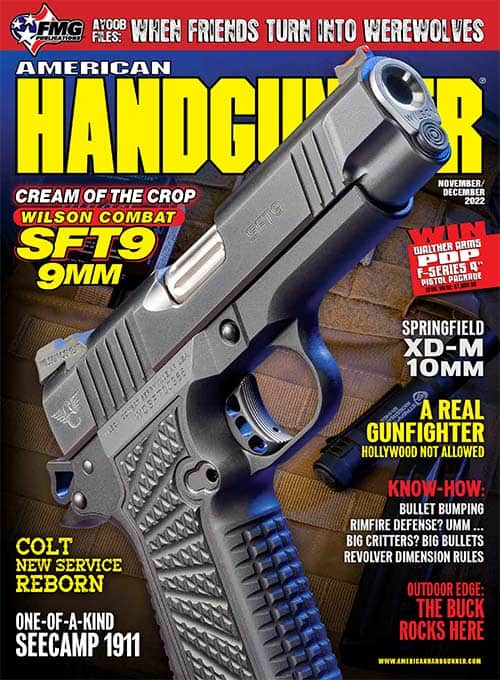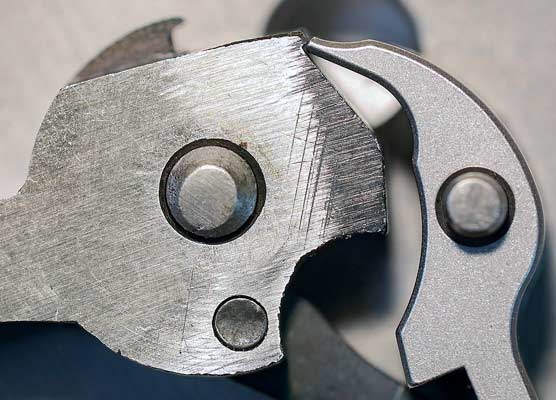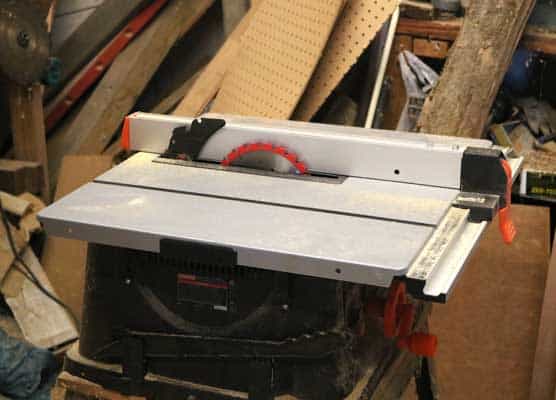Cream of the Crop:
Wilson Combat SFT9 9mm
Nothing floats cream to the top quite like accountability. There’s a reason why all those Delta Ninja Seal teams implement harsh after-action review sessions. By painstakingly reviewing what went right and what could be done better in the future, each team member is called to account to continuously raise the bar of their individual performance. The result is a finely tuned team machine, with all cylinders operating just a bit smoother with each passing iteration.
There’s also nothing quite like standing up and publicly stating one’s approval for their work to keep peak performance. Back in 1982, engineers at Apple applied their signatures to the inside of each Macintosh 128k, 512k and Mac Plus case. Do ya think they were proud of their work?
Custom Build Process
When I opened the soft carry case containing the new Wilson Combat SFT9 pistol, I risked forfeiting my man card by pulling out the instruction packet. Yeah, I know, we don’t need no stinkin’ directions, but hey, this is an expensive pistol, so I figured I would take a look in the interest of providing a full and complete report. Anyway, two 8.5 by 11 stray sheets caught my attention. The first was a Wilson Quality Control Checklist. The second was the test target report.
The target report illustrated the requisite shots on paper, listing specific load and such (5.2 grains of Power Pistol driving a 125-grain Hornady HAP bullet), but that’s not unusual. Lots of companies stick a spent cartridge case in the box, and some drop a target inside. This one went somewhat beyond with a listing of each pistolsmith who worked on this specific gun. Six craftsmen had their hands on the sample shown here, and I know their names. No home phone numbers, but I won’t nitpick.
The quality control checklist provided a detailed listing of 44 distinct inspections divided into custom build process, final assembly, test-firing and final inspection categories. Each step was initialed by the individual doing the inspection and covered everything from checking actual zero with live ammo to extractor movement and position. My favorite items on each subdivision of the list were simply labeled, “Overall job meets my approval.” You don’t want to be signing that statement unless you mean it.
The next time someone tells you a pistol in the four-figure price range is no different from one in the three-figure realm because they’ll both “do the job,” consider factors such as these. An Aston Martin Vanquish and AMC Gremlin are both capable of going forward, but few would draw an equivalent comparison.
SFT9 Heritage
The proven EDC9 begat the SFX9, which begets the new SFT9.
As a double-stack, sorta 1911-ish carry pistol, the EDC 9 featured design elements like a bushing-less bull barrel, double-stack 9mm capacity of 15 (and up depending on the variant) and a beautifully carved aluminum frame using removable side panels. The 9mm chambering allowed a double-stack configuration still managing to “weigh-in” with a lower overall circumference than a traditional 1911 grip. The length of pull to the trigger in the pistol’s medium configuration is right at that of a standard 1911.
The SFX9 pistol added a few design twists. The most visible differences are a solid frame design with Wilson’s distinctive “X” patterning cut into the frontstrap, backstrap, grip sides and the slide itself on fore and aft cocking positions. The SFX9 also added a bushing fit to the bull barrel and uses an external extractor design. The SFX9 also added a two-slot frame rail for accessories.
What’s An SFT9?
One can describe the SFT9 as having a frame similar to the SFX9 but with a rail-less configuration and Wilson’s TRACK pattern on the front and backstraps. The slide is essentially a 4.25″ 1911 Commander model. Unlike the flat tri-top slide cuts of the EDC and SFX models, the SFT features a rounded slide configuration with fine longitudinal grooves cut along most of the uppermost surface to provide a matte appearance, reducing glare. The classic 1911-like profile is all about smooth and comfortable concealed carry.
You’ll also note a traditional internal extractor in the SFT9. The SFT also loses the “X” pattern on the fore and aft cocking serrations, going instead with a more traditional aggressive vertical groove texture. The slide’s rear surface is covered with fine horizontal serrations to eliminate glare. The rear of the extractor is perfectly mated to the slide surface, and the grooves on the extractor and slide match perfectly. The slide settles in a perfectly flush position with the rear frame rails.
Like the SFX pistols, the SFT uses tightly fit bushing to align the 9mm bull barrel. While we’re talking about the barrel, note the heavily recessed crown. It’ll help protect the all-critical bore transition, and I have to say, it looks great. Aft of the locking lugs, you’ll see four fluted grooves on both sides. The integral feed ramp is polished mirror-smooth. While distorted from the curvature, you can quite literally see your reflection.
Sights
The sighting system shows the same attention to fine detail as everything else. The steel front sight housing contains a 1/2″-long fiber-optic tube. The remaining rear surface of the front sight is textured with horizontal grooves to reduce glare. That’s not something you’ll see on most off-the-line pistols.
The rear sight is ramped with a “U” notch. To reduce glare, most of the rear surface is finely grooved, but you’ll note a scooped-out smooth area surrounding the notch itself. From what I can see, this serves to draw the eye to the correct position more quickly.
Controls
As a “modified” 1911 design, there’s no grip safety. You carry this one cocked and locked, relying on the left side safety and trigger discipline to keep things locked up until you’re ready to fire. The safety lever is grooved for a bit of texture and clicks solidly into engaged and disengaged positions. I liked the feel.
I generally don’t use the slide lock to release the slide on magazine changes. The primary reason is by nature of the job, I’m using different pistols all the time. Slide lock levers are all different shapes and reside in different positions, so I’ve trained to perform the same action using a quick slide rack motion, which works the same with any pistol. There’s also the fail-safe element and benefit of using less-precision-required big muscles to do the job. However, if I were to carry the SFT9 daily, I’d consider kicking the rack habit. The pad on the slide lock lever is generously sized and positioned a tad closer to the grip. I can actually reach it with my firing hand thumb without wrecking my grip.
The magazine release button is also generously sized in the “vertical” direction. The button is more or less the same diameter as any other, but it’s “taller,” sticking out of the grip frame. The height, combined with a generous firing hand thumb cutout in the grip panel area, makes it easy to activate the magazine release without alteration of your grip.
Bottom line on the controls: They’re optimized for fighting if you’re right-handed. Lefties will want to make a couple of modifications.
Trigger
As the SFT9 has 1911 genes, the trigger action is a straight-back affair — no hinge motion. I measured about 1/16″ of pre-travel before pressure and another 1/16″ before a crisp break. Testing for reset by holding the trigger depressed after a dry-fire “shot,” I racked the slide and slowly released the trigger. The reset was crisp, easy to feel and audible.
I measured pull weight on this one right at 4 lbs., press after press.
Field Stripping
Like a standard 1911, you can perform most field-stripping chores sans tools, although you’ll want a 1/8″ punch to open the backstrap. More on that in a minute.
You can remove the guts by rotating the bushing by hand, but the fit is tight, so the included plastic bushing wrench will save some wear and tear on the fingers. A quarter-turn clockwise will release the recoil spring and plug. An eighth of a turn from home position counter-clockwise will unlock the bushing from the slide and allow removal of the bushing as well as the barrel.
To access the guts, including the mainspring housing, main spring, sear spring, etc., you’ll raise the hinged backstrap. Using the handy pin with a disc base, I pressed the grip downward on my bench, applying pressure through the flat disc and pin to the mainspring. This relieves tension and allows you to lift on the beavertail until the base of the backstrap can pull out of its locked position, lifting up and out of the way. Be patient. Things are tight, hence the successful approach of using the bench surface for increased leverage.
When you get things taken apart, have a look around. Think about the design and manufacturing challenges in creating this pistol from solid metal blocks. It’s impressive. You won’t find leftover cutting or machining marks scattered willy-nilly.
Handling
Before we get into the range performance stuff, I have to mention the subjective “handling” of this pistol. If we ignore the grip texture and someone placed this pistol in my hand while I was blindfolded, I’d say it feels an awful lot like a Hi-Power. I know “feel” is subjective, and your opinion may vary, but there’s just something about a Hi-Power grip…. The proportion of thickness to longitude and the height of the grip overall just works. The 15-round capacities cause the grip to end flush with the bottom side of my pinkie, so we’ve got a perfect balance of capacity and compact size
Not surprisingly, when I pull out a Hi-Power and look at it and the SF9 side by side, there’s a lot of similarity in the grip geometry. I think the Wilson folks pay a lot of attention to grip sculpture as I’ve also become a big fan of their custom grips for P320 series pistols — I’ve outfitted all of mine with Wilson grips too.
Shootin’
I elected to test this fine pistol with four different types of ammo, with a twist. All four are Wilson Combat loads.
For practice and general shooting, the remanufactured line is the way to go. It’ll save you a few bucks, and you give up nothing in the accuracy and reliability departments. The hollow-base, flat-nose projectile is a specially designed (by Bill Wilson) Berry’s extra-heavy plated 135-grain projectile. It’ll meet IDPA and USPSA power factors at just 926 fps. I chronographed this with a Competition Electronics ProChrono DLX placed 15 feet down range and recorded an average velocity of 923.4 fps. As for accuracy, I broke out the Ransom Multi-caliber Rest (think sandbags on steroids, not the vise solution) and set up at 25 yards for five-shot groups. Even with my decrepit eyes over iron sights, this ammo averaged 1.38″. No doubt an optic or Ransom Rest would improve those numbers.
The first of the three defensive loads tested was the TAC-XP +P. This load uses the outstanding Barnes solid-copper 115-grain projectile. It’s accurate and expands like few others. Over the chrony, this one averaged 1,122.5 fps. As for accuracy, again, from 25 over irons, I averaged 1.4″.
I finished up with two different loadings using the Hornady XTP bullet. The 124-grain +P load averaged 1,151.8 fps and produced 1.35″ groups. The subsonic XTP offering, at 147 grains, clocked in with an average of 982.8 fps. This load also won the accuracy competition with 0.89″ for five shots.
Parting Shots
There are guns, and there are “sweet” guns. You know the difference. I’d happily sell off a couple of “guns” to make room in the safe for a “sweet” SFT9. Everything about this pistol is slick. Handling, feel, performance and the all-important fit and finish one expects in a premium pistol. The MSRP on the SFT9 is a cool $3,095. All those gunsmiths who signed their names to this one can rest easy.
For more info: WilsonCombat.com


